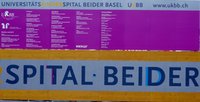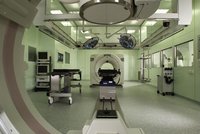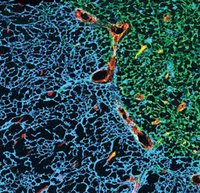Recent developments at the Faculty of Medicine
Increasing specialization and new medical diagnostic and treatment procedures have transformed and reshaped the landscape of the Faculty of Medicine. Recently, the faculty’s spectrum has also been expanded to include nursing and issues in medical ethics.
The evolution of everyday medical practice over the last sixty years becomes especially evident in looking at the equipment used in the field. Nearly fifty years ago, cardiologists’ only tools were stethoscopes and EKGs. The first computer tomograph in mainland Europe arrived in Basel in 1973, financed through special funding approved by the government and the Grand Council within just a few weeks. The device, acquired for 1.25 million Swiss francs, could be used only for brain scans and required four and a half minutes of measurement time for each double layer scanned, and then another seven and a half minutes for image reconstruction. Electron microscopy has been a general unit of the university’s central laboratory since 1956; in 1975, the Institute of Anatomy was able to purchase its first transmission electron microscopes, followed by a scanning electron microscope in 1980, and another transmission electron microscope with digital image storage in 1998.
Surgical procedures have been another area of innovation in the field. Organ transplantation saw a surge in the 1960s after it became possible to counter the problem of rejection with drug-induced immunosuppression. The range of surgical treatment options continued to expand and can now be individually tailored to the needs of patients. In the 1970s, one of the significant innovations in treating breast cancer was established – breast-conserving surgery, which spares many women the traumatic experience of mastectomy while fully maintaining oncological effectiveness. Alongside the diagnostic and surgical treatment of breast cancer, systemic therapy – primarily endocrine treatment methods and chemotherapy – rapidly advanced in the following years. Another optimization was the use of endoscopic methods in surgery.
The most recent focus of efforts on molecular and microbiological research is most clearly reflected in the Department of Biomedicine, which evolved from the former Department of Research. Today, fifty-nine research groups in the fields of immunology, neurobiology, and oncology, as well as stem cells and regenerative medicine, conduct research in the department.
The ongoing cooperation of the Faculty of Medicine with industry is evident in numerous projects, of which only two will be mentioned here. The Institute of Radio-Oncology became a pioneer in capturing and managing relevant patient data with the introduction and further development of a system integrated into the institute in 1981 for capturing and processing all oncologically relevant clinical data. This system, developed in close cooperation with industry, had captured data from more than 12,000 patients by the end of 1993 (Rodars: Radiation Oncology Data Archiving and Retrieving System). At the Geriatric Clinic, the chief physician’s involvement in the longitudinal BASEL study (begun in 1958), in collaboration with the pharmaceutical industry, has enabled research into the development of chronic diseases. This collaboration succeeded in characterizing the significance of nutrition in the development of cardiovascular diseases and cancer.
Public health and prevention play a pivotal role in the faculty today. The disciplines working in this area are united in the Department for Public Health. The Institute of Nursing Science takes a leading role in Europe in the university-level education of nursing professionals. The Institute for Biomedical Ethics is likewise pioneering a new path.
The role of the Faculty of Medicine in the university and political context
Apart from these academic aspects, the recent history of the Faculty of Medicine has also been shaped by local political developments. Like no other faculty, it, and particularly the financing of the clinical area, have played a significant role in the university’s reorganization in the decades around the turn of the millennium. The goal of this reorganization was to achieve greater autonomy in a partnership supported by the two cantons of Basel-City and Basel-Countryside. In March 1994, a new University Agreement was signed by both cantons, which, among other things, defined the contributions of the canton of Basel-Countryside to the clinical teaching and research of the University of Basel, especially the involvement of hospitals in the canton in the training of clinicians. This contract also tasked the faculty with separating the funds for teaching and research from the hospital budget and accounting for them separately from services. The University Act of 8 November 1995, and the University Statute of 1 March 1996, newly regulated the appointment process for professors of clinical medicine by introducing joint structural and election commissions with representatives from both cantons.





